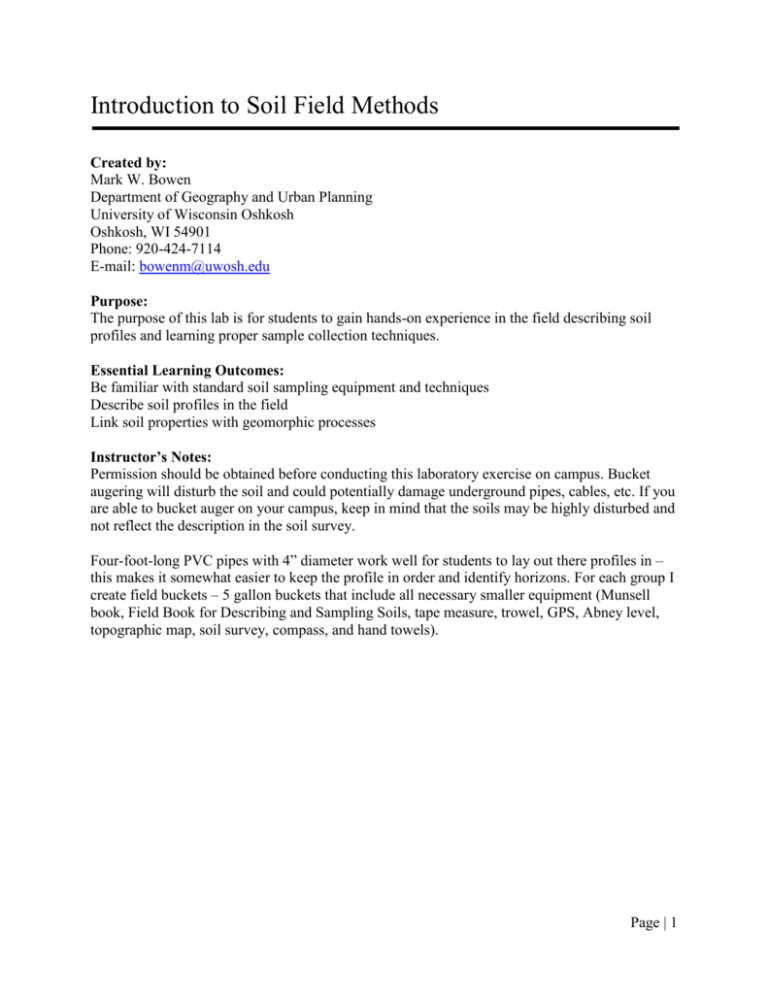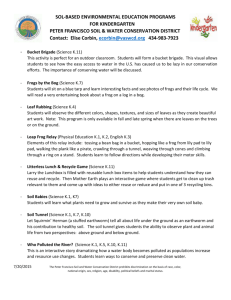Soil Field Methods exercise
advertisement

Introduction to Soil Field Methods Created by: Mark W. Bowen Department of Geography and Urban Planning University of Wisconsin Oshkosh Oshkosh, WI 54901 Phone: 920-424-7114 E-mail: bowenm@uwosh.edu Purpose: The purpose of this lab is for students to gain hands-on experience in the field describing soil profiles and learning proper sample collection techniques. Essential Learning Outcomes: Be familiar with standard soil sampling equipment and techniques Describe soil profiles in the field Link soil properties with geomorphic processes Instructor’s Notes: Permission should be obtained before conducting this laboratory exercise on campus. Bucket augering will disturb the soil and could potentially damage underground pipes, cables, etc. If you are able to bucket auger on your campus, keep in mind that the soils may be highly disturbed and not reflect the description in the soil survey. Four-foot-long PVC pipes with 4” diameter work well for students to lay out there profiles in – this makes it somewhat easier to keep the profile in order and identify horizons. For each group I create field buckets – 5 gallon buckets that include all necessary smaller equipment (Munsell book, Field Book for Describing and Sampling Soils, tape measure, trowel, GPS, Abney level, topographic map, soil survey, compass, and hand towels). Page | 1 Background: Fieldwork is an integral part of any soil laboratory exercise since soils must first be collected before they can be analyzed. It is extremely important to ensure that samples are collected as carefully and precisely as possible to reduce errors and eliminate opportunities for sample contamination. It is also important to add a geographic and geomorphic context to your sampling procedures, as they are intimately linked to soil forming factors. Therefore, sample collection is but one component of the fieldwork procedures. Soil samples can be collected from a variety of environments using various methods to expose the soil. One common, and often preferred method, is sampling of road cuts since the work of exposing a clean face for sampling has mostly been done for you. Digging a large pit, either by hand or with backhoe, is also common but is either very labor intensive or expensive. The third common method of soil sample collection is by collection through coring. Coring allows you to collect samples for the entire soil profile (or as deep as you can core) without having to expose a face for sampling. All three methods have advantages and disadvantages. Typical Field Equipment: Sturdy boots Field clothes Gloves Hat Camera Notebook Pencil Water Soil survey Shovel Trowel Tape measure GPS Water bottle Acid bottle Abney level Flagging Pins Backsaver Topographic maps Munsell Color Chart Field Book for Describing and Sampling Soils (Version 3.0) Pocket knife Pocket tool (i.e. Leatherman) Bandana Sample containers Compass Bucket auger Exercise: Complete a site description and soil profile description using the attached sheet. Collect a soil profile using a bucket auger to incrementally collect samples. Lay samples out on the ground to make a continuous profile. Complete descriptions for each bucket auger sample collected. Page | 2 Page | 3 Horizon Land cover: Name(s): Date: Lat-Long: Elevation: Geomorphic Position: Slope aspect: Slope gradient: Depth (cm) Color Structure Hand Texture Efferv. (PDP Code) Profile Description Site Description Site Notes Profile Notes 1. Using the maps in the back of the county soil survey, what soil series is the soil classified as? 2. Now turn to the soil series and morphology description for this soil in the text of the county soil survey and complete the following table: Horizon Depth (Inches) Munsell color Structure 3. How did the county soil survey description compare to your soil profile description? 4. What evidence is there that the soil profile has been disturbed by human activity? Consider indirect effects such as vegetation change, altered hydrology, nearby buildings and other structures and direct effects such as excavations, dumping material, etc. 5. Given what you know about soils in general and this soil in particular, is this a good location for the university to build on? Why or why not? Page | 4







